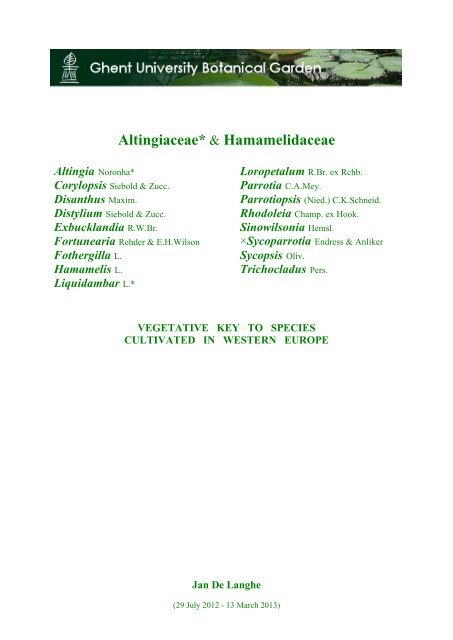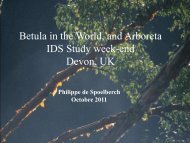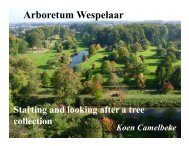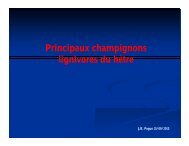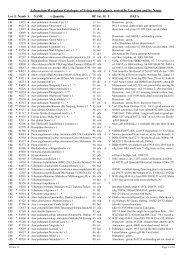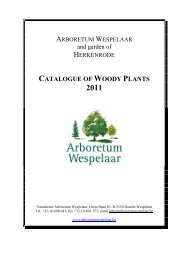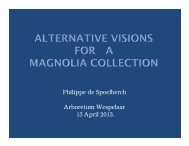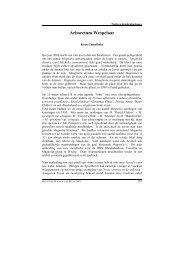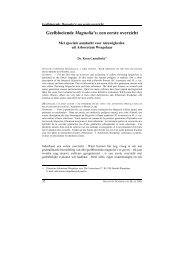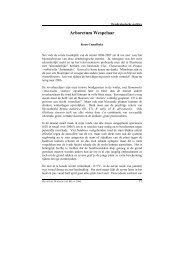Altingiaceae* & Hamamelidaceae - Arboretum Wespelaar
Altingiaceae* & Hamamelidaceae - Arboretum Wespelaar
Altingiaceae* & Hamamelidaceae - Arboretum Wespelaar
Create successful ePaper yourself
Turn your PDF publications into a flip-book with our unique Google optimized e-Paper software.
<strong>Altingiaceae*</strong> & <strong>Hamamelidaceae</strong>Altingia Noronha*Corylopsis Siebold & Zucc.Disanthus Maxim.Distylium Siebold & Zucc.Exbucklandia R.W.Br.Fortunearia Rehder & E.H.WilsonFothergilla L.Hamamelis L.Liquidambar L.*Loropetalum R.Br. ex Rchb.Parrotia C.A.Mey.Parrotiopsis (Nied.) C.K.Schneid.Rhodoleia Champ. ex Hook.Sinowilsonia Hemsl.×Sycoparrotia Endress & AnlikerSycopsis Oliv.Trichocladus Pers.VEGETATIVE KEY TO SPECIESCULTIVATED IN WESTERN EUROPEJan De Langhe(29 July 2012 - 13 March 2013)
Vegetative key.This key is based on vegetative characteristics, visible during the longest period of the year.Taxa treated in this key: see page 6.Taxa referred to synonymy in this key: see page 6.Questionable/freguently misapplied names: see page 6.To improve accuracy:- Use a hand lens to judge pubescence in general.- Start counting veins at base of the lamina with first clearly ascending secondary vein, do notinclude veins ending in the apex.- Look at the entire plant. Young specimens and strong shoots give an atypical view.- Beware of hybridisation, especially with plants raised from seed gathered in collections.Features based on:- JDL herbarium specimens- living specimens, in various arboreta, botanic gardens and collections- literature:Andrews, S. & Hsu, E. - (2004) - Liquidambar as Tree of the Year in IDS yearbook, p.11-45.Bean, W.J. - (1980) - Corylopsis in Trees and Shrubs hardy in the British Isles VOL.1, p.717-721.Bean, W.J. - (1981) - Disanthus in Trees and Shrubs hardy in the British Isles VOL.2, p.62.Bean, W.J. - (1981) - Distylium in Trees and Shrubs hardy in the British Isles VOL.2, p.65-66.Bean, W.J. - (1981) - Fortunearia and Fothergilla in Trees and Shrubs hardy in the British Isles VOL.2, p.204-206.Bean, W.J. - (1981) - Hamamelis in Trees and Shrubs hardy in the British Isles VOL.2, p.315-321.Bean, W.J. - (1981) - Liquidambar in Trees and Shrubs hardy in the British Isles VOL.2, p.581-584.Bean, W.J. - (1981) - Loropetalum in Trees and Shrubs hardy in the British Isles VOL.2, p.628.Bean, W.J. - (1987) - Parrotia and Parrotiopsis in Trees and Shrubs hardy in the British Isles VOL.3, p.90-93.Bean, W.J. - (1981) - Sinowilsonia in Trees and Shrubs hardy in the British Isles VOL.4, p.369.Bean, W.J. - (1981) - Sycopsis in Trees and Shrubs hardy in the British Isles VOL.4, p.522.Chang, C. & Chang, K.S. - (2010) - Typification of Corylopsis coreana in Journal of Japanese Botany VOL.85, p.270-276.Clarke, D.L. - (1988) - Corylopsis in Trees and Shrubs hardy in the British Isles supplement, p.187-188.Grimshaw, J. & Bayton, R. - (2009) - Exbucklandia in New Trees, p.365-368.Ickert-Bond, S.M., Pigg, K.B. and Wen, J. - (2007) - Comparative infructescence morphology in Altingia in American Journal of Botany 94(7), p.1094-1115.Iwatsuki, K., Boufford, D.E. & Ohba, H. - (2001) - <strong>Hamamelidaceae</strong> in Flora of Japan VOL.2b, p.5-9.Krüssmann, G. - (1976) - Corylopsis in Handbuch der laubgehölze VOL.1, p.406-408.Krüssmann, G. - (1976) - Disanthus in Handbuch der laubgehölze VOL.1, p. 479.Krüssmann, G. - (1976) - Distylium in Handbuch der laubgehölze VOL.1, p.480.Krüssmann, G. - (1977) - Fortunearia in Handbuch der laubgehölze VOL.2, p.81.Krüssmann, G. - (1977) - Fothergilla in Handbuch der laubgehölze VOL.2, p.83.Krüssmann, G. - (1977) - Hamamelis in Handbuch der laubgehölze VOL.2, p.126-129.Krüssmann, G. - (1977) - Liquidambar in Handbuch der laubgehölze VOL.2, p.233-234.Krüssmann, G. - (1977) - Loropetalum in Handbuch der laubgehölze VOL.2, p.266.Krüssmann, G. - (1977) - Parrotia and Parrotiopsis in Handbuch der laubgehölze VOL.2, p.370-371.Krüssmann, G. - (1978) - Rhodoleia in Handbuch der laubgehölze VOL.3, p.205-206.Krüssmann, G. - (1978) - Sinowilsonia in Handbuch der laubgehölze VOL.3, p.337.Krüssmann, G. - (1978) - ×Sycoparrotia and Sycopsis in Handbuch der laubgehölze VOL.3, p.391.Lane,C. - ( 2005) - Witch Hazels, 227 p.Morley, B. & Chao, J. - (1977) - A review of Corylopsis in Journal of the Arnold <strong>Arboretum</strong>, Harvard University, VOL.58 n°4, p.382-454.Ohwi, J. - (1965) - <strong>Hamamelidaceae</strong> in Flora of Japan, p. 516-517.Rehder, A. - (1940) - <strong>Hamamelidaceae</strong> in Manual of cultivated trees and shrubs hardy in North America, p.311-319.Walker, E.H. - (1944) - A revision of Distylium and Sycopsis in Journal of the Arnold <strong>Arboretum</strong>, Harvard University, VOL.25, p.319-341.Weakley, A. - (working draft 15 May 2011) - Fothergilla, Hamamelis and Liquidambar in Flora of the Southern and Mid-Atlantic States, p.390-392.Zhiyun, Z., Hongda, Z., Hung-ta, C. and Endress, P.L. - (2003) - <strong>Hamamelidaceae</strong> in Flora of China VOL.9, p.18-42.I am particularly grateful to Wolfgang Bopp, Peter Brownless, Koen Camelbeke, Tom Clark, Francisco Garin, Tom Hudson, PaulGoetghebeur, John Grimshaw, Jaime Morin, Abraham Rammeloo and Paul Reader for extra help with constructive commentsand specimens.Also thanks to the responsible persons of various arboreta, botanic gardens and collections where I could collect herbariumspecimens since 1982.My explicit thanks for their support goes to <strong>Arboretum</strong> Kalmthout, <strong>Arboretum</strong> <strong>Wespelaar</strong>, Ghent University BotanicalGarden, Hillier Gardens and <strong>Arboretum</strong>, Iturraran Botanical Garden, Royal Botanic Gardens Edinburgh and Polly Hill<strong>Arboretum</strong>.Copyright © 2012-2013 Jan De LangheNon-commercial use with mentioning "Jan De Langhe - Ghent University Botanical Garden" please.http://www.plantentuin.ugent.be- 1 -
01 a Lamina venation palmate (with basal veins departing from 1 point). ................................. 02b Lamina venation pinnate, OR +/- 3(-5)-veined at base (with basal veins departing fromseveral points). ......................................................................................................................... 0802 a Lamina margin entire at least in part of the leaves. ............................................................. 03b Lamina always lobed. ............................................................................................................... 0403 a Lamina papery, apex acute to obtuse. Stipules caducous. ............. Disanthus cercidifoliusb Lamina leathery, apex acuminate to caudate. Stipules long persistent............................................................................................................. Exbucklandia populnea04 a Mature leaves with lamina predominantly 5-7 lobed (on young shoots 3-lobed laminas mayoccur). ....................................................................................................................................... 05b Mature leaves with lamina predominantly 3-lobed (on young and strong shoots also 5-lobedlaminas occur). ........................................................................................................................... 0705 a Terminal lobe with small lateral lobes. ............................................... Liquidambar orientalisb Terminal lobe not lobed or only occasionally (slightly) lobed in part of the leaves. ........ 0606 a Plant deciduous, 3-lobed laminas absent. ...................................... Liquidambar styracifluab Plant evergreen or almost so, young/strong growth often with 3-lobed laminas.......................................................................................................... Liquidambar macrophylla07 a Petiole base stipulate. ......................................................................... Liquidambar acalycinab Petiole base exstipulate. ................................................................... Liquidambar formosanadifferences???. ...................................................................................... Liquidambar formosana Monticola Group08 a Most secondary veins curving and anastomosing before the margin. .............................. 09b Most secondary veins and their forks ending at margin. .................................................... 2109 a Petiole 10-30(-60) mm. ............................................................................................................. 10b Petiole ≤10(-12) mm. ................................................................................................................. 1510 a Petiole densely brownish stellate pubescent, lamina LS pale and densely pubescent. .. 11b Petiole glabrous, lamina LS +/- glaucous to green and glabrous. ...................................... 1211 a Leaves alternate. .................................................................................. Trichocladus ellipticusb Leaves often opposite. ........................................................................... Trichocladus crinitus12 a Lamina LS +/- glaucous, minutely dotted (10× LENS). .... Rhodoleia championii sensu latob Lamina LS green, not dotted. .................................................................................................. 1313 a Lamina midvein length
15 a Lamina US secondary veins impressed. ............................................................................... 16b Lamina US secondary veins raised or +/- indistinct. ............................................................ 1716 a Lamina elliptic-lanceolate; base cuneate, apex acuminate. ..................... Sycopsis sinensisb Lamina ovate-elliptic; base oblique, apex acute to obtuse. ............. Loropetalum chinense- Foliage brownish to reddish purple. ....................................................................... Loropetalum chinense var. rubrum17 a Lamina predominantly narrowly oblong (-oblanceolate), petiole ≤4 mm. .......................... 18b Lamina predominantly elliptic to obovate, petiole 5-12 mm. ............................................... 1918 a Lamina base narrowly cuneate, midvein length predominantly 25 teeth or vein endings/side. ............................................................ 22b Lamina margin with ≤25 teeth or vein endings /side. ........................................................... 2322 a Lamina base rounded to cuneate (margin irregularly dentate from finely serrate-dentate tocoarsely dentate). ....................................................................................... Fortunearia sinensisb Lamina base cordate to obliquely cordate (margin predominantly regularly finely serrate)..................................................................................................................... Sinowilsonia henryi23 a Lamina margin dentate with teeth bristly at apex. ................................................................ 24b Lamina margin undulate to +/- coarsely dentate, teeth apex not bristly. ........................... 3424 a Mature lamina with largest width predominantly above the middle: obovate to oblongelliptic, OR obovate to broadly ovate. .................................................................................... 25b Mature lamina with largest width predominantly in or below the middle: (broadly) ovate,OR ovate to +/- orbicular. ........................................................................................................ 2625 a Lamina midvein length 7-12 cm AND apex with acute tip. .................... Corylopsis sinensis- Lamina LS and petiole predominantly pubescent. ............................................ Corylopsis sinensis var. sinensis- Lamina LS and petiole predominantly glabrous glabrescent. ..................... Corylopsis sinensis var. calvescensb Lamina midvein length 7-15 cm AND apex with acute to caudate tip. Corylopsis multiflora26 a Lamina midvein length predominantly ≤6 cm. ..................................... Corylopsis pauciflorab Lamina midvein length varying from 5-15 cm. ...................................................................... 2727 a Lamina apex acute to acuminate at tip. ................................................ Corylopsis multiflorab Lamina apex acute to abruptly acute at tip. .......................................................................... 28- 3 -
28 a Petiole 3-6 cm. ...................................................................................... Corylopsis himalayanab Petiole ≤3 cm. ........................................................................................................................... 2929 a Lamina midvein length/width ≥2/3, margin with shallow teeth and short bristles. ........... 30b Lamina midvein length/width 15 teeth/side. . Parrotiopsis jacquemontianab Lamina predominantly ovate, elliptic or obovate, IF (rarely) suborbicular then with 7 cm: margin entire in basal 1/3-2/3........................................................................................................................... Parrotia persicab Lamina midvein length predominantly
41 a Low shrub 5secondary veins/side at least in part of the leaves. ............................................................. 4242 a Lower most basal secondary vein often runs out above lamina basal 2/3.............................................................................................................. Fothergilla ×intermediab Lower most basal secondary vein often runs out below lamina basal 2/3........................................................................................................................ Fothergilla major43 a Shrub to small tree. Lamina rhombic to obovate, margin upper half predominantlyshallowly undulate dentate. ..................................................................... Hamamelis japonicab Stoloniferous shrub. Lamina margin upper half predominantly coarsely undulate dentateand also +/- (finely) undulate lower half. .................................................. Hamamelis vernalis44 a Lamina LS pubescence restricted to veins or absent. ....................... Hamamelis virginianab Lamina LS +/- densely pubescent. ......................................................................................... 4545 a Lamina base (at least at one side) predominantly entire or almost so (basal secondaryvein forks anastomosing before margin). ............................................................................. 46b Lamina base predominantly undulate to minutely dentate (basal secondary vein forksending at margin). ..................................................................................................................... 4746 a Lamina midvein length predominantly >12 cm. ......................................... Hamamelis ovalisb Lamina midvein length
Taxa treated in this key.Altingia excelsaAltingia gracilipesAltingia poilaneaCorylopsis coreanaCorylopsis glabrescensCorylopsis gotoanaCorylopsis himalayanaCorylopsis multifloraCorylopsis paucifloraCorylopsis platypetalaCorylopsis sinensis- var. calvescens- var. sinensisCorylopsis spicataCorylopsis willmottiaeDisanthus cercidifoliusDistylium buxifoliumDistylium macrophyllumDistylium myricoidesDistylium racemosumExbucklandia populneaFortunearia sinensisFothergilla gardeniiFothergilla ×intermediaFothergilla majorHamamelis japonicaHamamelis mexicanaHamamelis mollisHamamelis ovalisHamamelis vernalisHamamelis virginianaHamamelis mollis × Sycopsis sinensisLiquidambar acalycinaLiquidambar formosanaLiquidambar macrophyllaLiquidambar orientalisLiquidambar styracifluaLoropetalum chinenseParrotia persicaParrotia subaequalisParrotiopsis jacquemontianaRhodoleia championii sensu latoSinowilsonia henryi×Sycoparrotia semideciduaSycopsis sinensisTrichocladus ellipticusHamamelis ×intermediaTaxa referred to synonymy in this key.Altingia gracilipes var. serrulata = A. gracilipesCorylopsis griffithii = C. himalayana var. griffithiiCorylopsis wilsonii = C. multifloraQuestionable/frequently misapplied names.Plants in collections named Rhodoleia henryi and R. parvipetala are not reliably distinguishable from each other nor from R. championii,certainly not by vegetative characters and belong in this key to Rhodoleia championii sensu lato.Plants in collections named Sycopsis tutcheri and Distyliopsis tutcheri (with lamina US secondary veins indistinct to slightly raised and apexacute to acuminate) are Distylium racemosum, and not Distyliopsis tutcheri (taxon not seen yet and not in this key: with lamina US secondaryveins impressed and apex obtuse to +/-acute).Part of the plants in collections named Distylium myricoides (with lamina +/- oblong, in part of the leaves >50 × 15 mm and apex obtuse to +/-acute) are provisionally named D. myricoides Hort. in this key (maybe it are D. buxifolium hybrids similar to the American selections D. 'BlueCascade', D. 'Emerald Heights' and D. 'Vintage Jade').1 2 3 4 5 6 7 8 9 10 11 12 13 14 15 cm- 6 -


